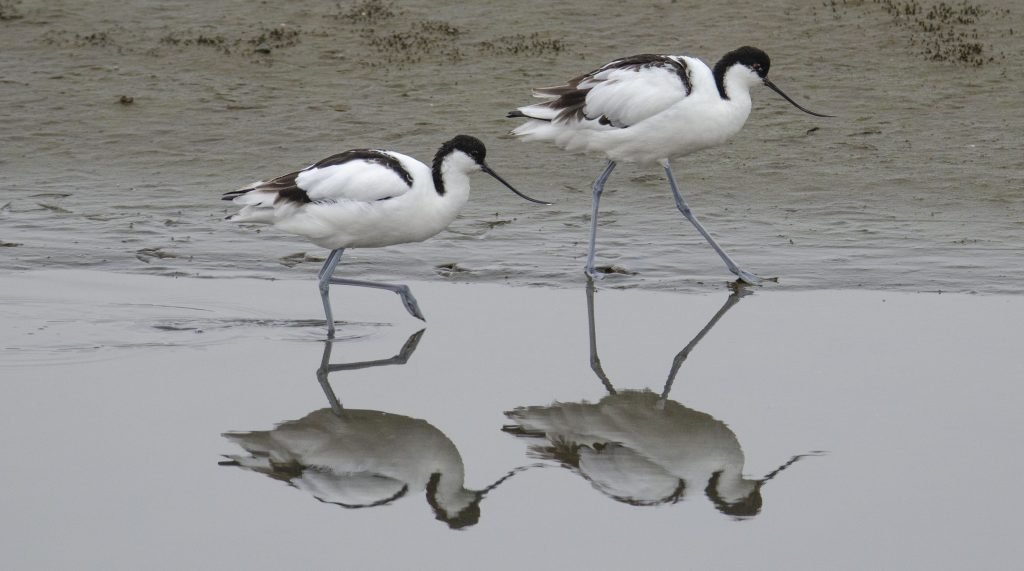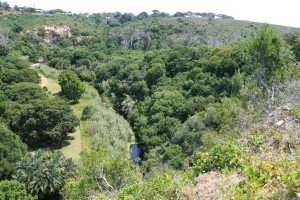False Bay Coastal Park 0

The False Bay Coastal Park, in particular the Strandfontein Sewage Works, is a waterbird mecca and it provides just the right sort of habitat for one of my favourite birds – the Pied Avocet.
Having spent most of my life in KwaZulu-Natal and done most of my birding in lowveld areas, the Pied Avocet is not a run-of-the-mill sighting for me. As the name ‘Pied’ makes clear, this wader features just two colours – black and white – and yet the combination of them is so perfect, so crisply elegant and pleasing to the eye.
Added to this is the sight of their unusual bill – long, thin and upcurved – and their stately comportment, walking slowly through shallow water while swiping right … and left … with their scything bill to capture small crustaceans and insect larvae, which just makes them thoroughly interesting and pleasant to watch.
They have become particularly fond of artificial water bodies, especially saline or nutrient-rich ones. So sewage works have been a particular boon for this species.
And the Strandfontein Sewage Works, which are the central feature of the False Bay Coastal Park, situated between Muizenberg and Mitchell’s Plain, occasionally holds globally significant numbers of Pied Avocet – at times as many as 1% (550) of the African population, thereby qualifying as an Important Bird Area trigger species.
On this visit, on a lovely sunny evening in late March with a fresh breeze blowing, there were discrete handfuls of this nomad on the settling ponds.
With them were Blackwinged Stilts, also a member of the long-legged, long-billed Recurvirostridae family.
There are 20 different pans at Strandfontein, linked by a system of tracks which a normal sedan car can comfortably navigate, except sometimes for those next to Baden Powell Drive which runs right alongside False Bay and the ocean.
The pans have differing water-levels, some of them manually manipulated, which means they provide subtly different habitats – from reedbeds to large expanses of open water, both shallow and deep – and their different features range from artificial roosting platforms to well-vegetated edges, coastal dunes and sand islands.
This promotes a high diversity of species which is why 76 different waterbird and 18 coastal birds have been recorded at Strandfontein. And they are there in their numbers, making it a popular destination for large numbers of birders from all over the country. And every now and then a national rarity pops up; it really does feel like anything is possible on or above the pans or in the Cape Flats Dune Strandveld surrounding them.
My sightings at the end of summer were more mundane, but still enough to whet the appetite for future visits.
The near-endemic, plankton-loving Cape Shoveller can be uncommon elsewhere in South Africa, but is common in the sea-level freshwater wetlands around False Bay, and it was joined by other Anatids in Yellowbilled Duck, Cape Teal and Spurwinged Goose, while Kelp Gulls were common, flying over the coastal dunes and nearby dump site.
Lots of Hadeda and Sacred Ibis were along the fringes of the pans, along with Cattle Egret, Blacksmith Plover, Cape Wagtail and Grey Heron. Redknobbed Coots quietly munched on water weeds, Dabchicks appeared and then disappeared again as they dived underwater, and Whitebreasted Cormorants were standing around drying themselves before contemplating heading off to roost.
Cape Reed Warblers gave their rich, bubbly calls from inside the reedbeds, before one eventually came into view at the top of the stalks. European Swallows owned the skies above the pans.
The grassy areas where one enters the False Bay Coastal Park are also good for birding. A Jackal Buzzard was standing sentry at the entrance before patrolling for rodents in the verges of the tar road.
The road goes along the eastern end of Zeekoevlei, and has picnic sites underneath a row of Eucalyptus trees; a Pied Crow was flying around looking for scraps and even a Small Grey Mongoose came dashing from cover to see what morsels it could find.
The bushier areas mark the beginning of the Cape Flats Dune Strandveld, an endangered vegetation type unique to this area. It is prime habitat for the Cape Grassbird, an endemic skulker that is not often seen despite its long tail, but on this occasion I was sharp enough to be fortunate.
Karoo Prinia is another endemic and a habitat generalist as long as it has some shrubby thickets to dive into when disturbed, and it was spotted on one of the dune ridges close to the Grassbird.
A Blackshouldered Kite perched nearby and kept a beady red eye on proceedings.
Birders are well-advised to watch like a hawk in the False Bay Coastal Park because one will seldom be disappointed given the number of species that frequent this area. And there is always the possibility of spotting a rarity. That’s what I’ll be hoping for next time I’m there.
Sightings List
Jackal Buzzard
Small Grey Mongoose
Spurwinged Goose
Kelp Gull
Blackshouldered Kite
Cape Grassbird
Hadeda Ibis
Karoo Prinia
Pied Crow
Cattle Egret
Blacksmith Plover
Cape Teal
Yellowbilled Duck
Dabchick
Cape Shoveller

Sacred Ibis
European Swallow
Cape Wagtail
Whitebreasted Cormorant
Grey Heron
Pied Avocet
Blackwinged Stilt
Cape Reed Warbler
Redknobbed Coot
